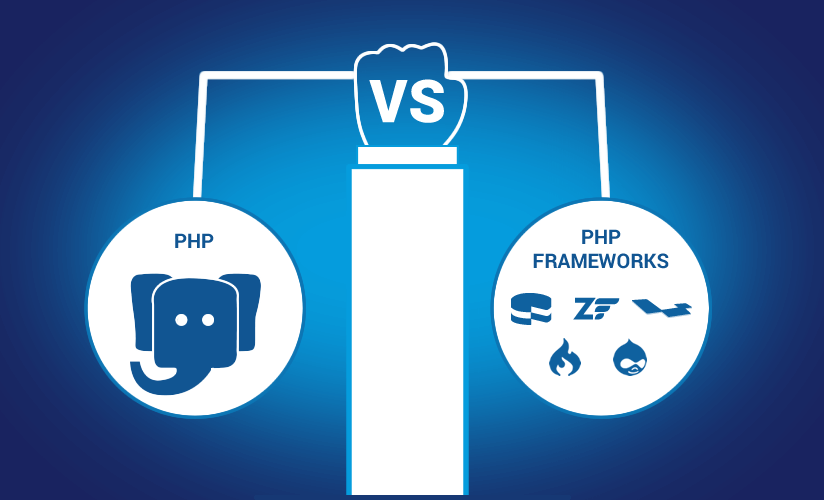10 Reasons Why Vue.js Is Best for App Development

Are you tired of sifting through endless JavaScript frameworks and libraries in search of the perfect one for your app development project? Look no further! Vue.js is here to save the day (and your sanity).
But seriously, Vue.js has gained a loyal following among developers for good reason. It’s a powerful and versatile framework that provides a streamlined development experience. And let’s be real, in the world of software development, anything that can make our lives a little easier is a win.
Plus, Vue.js has some impressive stats to back up its reputation, with a satisfaction rating of 73.6% among developers and over 2 million weekly downloads on npm.
In this blog, we’re going to dive into the top ten reasons why Vue.js is the best choice for app development. So sit back, relax, and get ready to know how it can help you create robust and scalable applications.
An Overview of Vue.JS:
Vue.js is an open-source progressive JavaScript framework used for building user interfaces and single-page applications. It was developed by Evan You in 2014 and has since gained widespread adoption among developers. Vue.js is known for its simplicity, flexibility, and versatility, which makes it a popular choice for building applications of all sizes and complexities.
One of the key features of Vue.js is its intuitive syntax and template-based syntax, which makes it easy to learn and use. It also allows for seamless integration with other libraries and tools, which makes it a versatile choice for developers. Vue.js has a modular architecture that allows developers to scale their applications without compromising on performance. It also provides a reactive and composable data-binding system that makes it easy to manage complex user interfaces.
Vue.js is designed to be incrementally adoptable, which means that developers can start using it in small parts of their applications and gradually build up to using it for the entire application. It also has a vibrant and supportive community that provides ample resources and support to developers.
How Does it Work? 
Vue.js is like a magical potion for web developers that helps them create amazing user interfaces with ease. Here’s a rundown of how it works:
- Declarative rendering: With Vue.js, you can declare the structure of your web page using a template-based syntax. It’s like giving your computer a blueprint to follow.
- Component-Based Architecture: Vue.js lets you create reusable components that you can mix and match to create complex user interfaces. Think of it as a giant box of Lego bricks that you can use to build anything you want.
- Reactive Data Binding: Vue.js is like a psychic medium that can communicate between your data and the user interface. Any changes you make to the data are instantly reflected in the user interface, and vice versa. It’s like they’re in sync!
- Virtual DOM: Vue.js uses a virtual DOM, which is like a stunt double for the actual DOM. It performs all the risky DOM manipulations behind the scenes, so your web page can stay safe and sound.
- Directives: Vue.js provides you with directives, which are like little helpers that can add some magic to your web page. They can do things like conditionally render elements, manipulate the DOM, and bind data.
In short, Vue.js is like having a wizard on your team that can help you create amazing user interfaces in a snap. With its powerful features, you can make your web page look and feel like magic. We’ll dive deep into all these features in the next section.
10 Reasons Why Vue.js is Best for App Development:
Vue.js is a popular JavaScript framework that has gained a lot of attention from developers for its simplicity, flexibility, and performance. Here are ten reasons why Vue.js is the best choice for app development:
Lightweight and Fast:
The first reason why Vue.js is the best choice for app development is that it is lightweight and fast. This means that Vue.js has a smaller size than other popular frameworks like React and Angular, making it quick to download and easy to use.
When a user visits a web page built with Vue.js, the web page loads quickly, providing a smooth and seamless experience. This is especially important in today’s fast-paced world, where users expect applications to load quickly, or they may quickly lose interest and move on to something else.
Moreover, Vue.js is designed to be performant, which means that it can handle complex applications with ease. Its performance is further enhanced by its virtual DOM, which minimizes the number of updates that need to be made to the actual DOM, making it faster and more efficient.
Easy to Learn:
The second reason why Vue.js is an excellent choice for app development is that it is relatively easy to learn, even for beginners.
Vue.js’s syntax is intuitive and easy to understand, making it easier for developers to read, write, and maintain their code. The framework is built to be approachable, with a simple and elegant API that is easy to grasp.
Additionally, Vue.js has an excellent documentation website that provides comprehensive guides, tutorials, and examples. This makes it easier for developers to get started quickly and learn the framework’s features and best practices.
Another advantage of Vue.js is that it has a small learning curve, allowing developers to get up to speed with the framework relatively quickly. This is because Vue.js only focuses on the essentials and does not include unnecessary features or abstractions that can make the learning process more complicated.
Flexible:
The third reason why Vue.js is a great choice for app development is its flexibility. Vue.js is a versatile framework that can be used in different ways, depending on the project’s requirements.
Vue.js is designed to be flexible and can work seamlessly with other libraries and frameworks, including React and Angular. Developers can choose to integrate Vue.js into their existing projects or use it as a standalone framework for new projects. This flexibility allows developers to use the framework in a way that best suits their needs and preferences.
Another advantage of Vue.js’s flexibility is that it can be used to build a variety of applications, from simple to complex, including single-page applications, mobile apps, and progressive web applications. Vue.js’s versatility means that developers can use it to build a range of projects without having to learn a new framework for each one.
Vue.js also provides developers with the flexibility to customize the framework to meet their specific requirements. The framework’s modular architecture(which we will cover next) allows developers to use only the components they need, reducing the application’s size and complexity.
Modular Architecture:
The modular architecture of Vue.js is an essential feature that allows developers to build applications with reusable components. In other words, Vue.js provides developers with a way to break down an application into smaller, more manageable parts, which can be developed, tested, and maintained independently.
Vue.js uses a component-based approach, which means that developers can create self-contained components that encapsulate a specific piece of functionality. These components can be used across the application, making it easier to maintain and update the application.
Vue.js components are written in HTML, CSS, and JavaScript, and they can be easily added or removed from the application as needed. This modularity makes Vue.js a flexible choice for building applications, allowing developers to mix and match components from different sources to create a customized solution that meets their specific needs. Although, you need to partner with the top app development companies like Imenso Software to fully utilize these features of Vue.js.
Two-Way Data Binding:
Two-way data binding is a feature of Vue.js that allows for the automatic synchronization of data between the model (the data in the component) and the view (the HTML template that displays the data).
In traditional one-way data binding, changes made to the model are reflected in the view, but changes made to the view are not reflected in the model. With two-way data binding, however, changes made to the view are automatically propagated back to the model, and vice versa.
This means that when a user interacts with an input element (like a text box) in the view, any changes made to the data in the input element are automatically updated in the model, without the developer having to write additional code to handle the update.
Similarly, if the data in the model changes, the view is automatically updated to reflect the new data, without requiring the developer to manually update the view.
Two-way data binding can save a lot of time and effort for developers, as it reduces the need for manual data synchronization code. It also improves the user experience, as any changes made by the user are immediately reflected in the application.
Reactive Computed Properties:
Reactive computed properties are a feature of Vue.js that allows developers to create properties in a component that automatically updates whenever their dependent properties change.
Computed properties are functions that return a value based on other properties in the component, and when any of these dependent properties change, the computed property is automatically re-evaluated and updated.
This reactive behavior ensures that the computed properties always have the most up-to-date value, without requiring the developer to update them manually.
Reactive computed properties can be used to simplify complex calculations, reduce code duplication, and improve performance by only updating what needs to be updated.
Easier App Building With Vue CLI:
Vue CLI (Command Line Interface) is a tool that simplifies the process of creating and managing Vue.js applications. It provides a streamlined set of tools and configurations to help developers quickly set up a project, including pre-configured web pack settings, a development server, and optimized production builds. Vue CLI also offers a plugin-based architecture that allows developers to easily add functionality to their projects, such as linting, testing, and deployment tools. This makes it easier for developers to focus on building their applications, rather than on the setup and configuration of their development environment.
Vuex to Develop more Scalable and Maintainable Apps:
Vuex is a state management pattern and library for Vue.js applications. It provides a centralized store that holds the state of an application and allows components to access and modify that state in a predictable and reactive way.
Vuex simplifies the process of managing application-level states by providing a clear separation between the state and the business logic of the application. It also provides a set of tools for tracking state changes, debugging, and testing. By using Vuex, developers can create applications that are more scalable, maintainable, and easy to reason about.
Vue Router:
Vue Router is a library for Vue.js applications that provides a way to handle client-side routing. Client-side routing allows for the creation of single-page applications (SPAs) where the navigation between pages happens without refreshing the whole page.
Vue Router uses a declarative syntax to define the routes of an application and map them to specific components. It also provides a way to handle dynamic routing, where the parameters in the URL can be used to load different components or data.
Vue Router also offers advanced features like lazy loading of components, which means that components are only loaded when they are needed, improving the performance of the application.
Active Community:
Active community refers to the large and engaged community of developers and users who contribute to the Vue.js ecosystem. This community provides support, resources, and tools for developers who are using Vue.js, making it easier to learn and use the framework effectively.
The active community behind Vue.js is constantly creating new plugins, libraries, and tools to extend the functionality of the framework and solve common problems that developers face. This means that developers can leverage the work of others to build applications more efficiently and effectively.
The community also provides a wealth of resources for learning Vue.js, including tutorials, articles, and documentation. Additionally, there are numerous conferences, meetups, and forums where developers can connect and share their knowledge and experiences with Vue.js.
Best Practices for Using Vue.js for App Development: 
Keep your components small and focused:
One of the core principles of Vue.js is its component-based architecture. To make your components reusable and maintainable, it’s important to keep them small and focused on one specific task. This makes them easier to test and reason about.
Use Vuex for state management:
Vuex is a state management library that provides a centralized store for all your application’s states. It helps you manage complex application states and makes it easy to share data between components. Using Vuex can also help you avoid prop drilling and make your code more organized.
Use Vue Router for client-side routing:
Vue Router is the official router for Vue.js, and it provides a way to handle client-side routing in your application. It makes it easy to navigate between different pages or views in your app without doing a full page refresh.
Use computed properties and watchers:
Computed properties and watchers are two powerful features in Vue.js that allow you to update the DOM in response to changes in your data. Computed properties are used to calculate and return a value based on other data properties in your component, while watchers allow you to perform side effects when a particular data property changes.
Use v-if and v-for wisely:
v-if and v-for are two of the most commonly used directives in Vue.js, but they can have a big impact on performance if not used wisely. v-if should be used to conditionally render a component based on a boolean value, while v-for should be used to loop over an array and render a list of items.
Use lifecycle hooks:
Vue.js provides a set of lifecycle hooks that allow you to perform actions at specific points in a component’s lifecycle. These hooks include created, mounted, updated, and destroyed, among others. Using lifecycle hooks can help you manage component states and keep your code organized.
Use Vue.js dev tools:
The Vue.js dev tools are a browser extension that allows you to inspect the state and performance of your Vue.js applications. It’s an invaluable tool for debugging and optimizing your code.
Wrapping it Up:
Vue.js is a popular JavaScript framework used for building interactive web applications. In this blog, we have discussed 10 reasons why Vue.js is the best choice for app development. From its simplicity and ease of use to its flexibility and scalability, Vue.js offers a range of benefits that make it stand out from other JavaScript frameworks.
We have also highlighted some of the best practices for using Vue.js to ensure optimal performance and maintainability of your application. If you have a project in mind make sure to get in contact with the experts at Imenso Software and get a free estimate!
Similar Posts

How AI is Shaping the Next Generation of Software Development
Artificial intelligence is the most discussed topic in technology. It is frequently the subject of office conversations on Slack. International headline news also features artificial intelligence. AI technology continues to witness significant development and rapid growth. ChatGPT’s success, with over a hundred million users in two months, has flagged the manner for sustained boom and […]...

Exploring the Power of PHP: Use Cases and Best Practices
Are you a developer seeking a powerful and versatile solution for your web development projects? Have you been pondering over the perfect language to breathe life into your innovative ideas and turn them into reality? Look no further, as we present to you the answer to your web development quest: PHP – a dynamic scripting […]...

Core PHP vs PHP Frameworks
PHP has been a cornerstone of web development for a long time. The LAMP stack (Linux, Apache, MySQL, and PHP) is still a frequently used part of web development, and it is something that people tend to learn in computing courses in college. Today, there are many other frameworks that web applications can be built […]...










